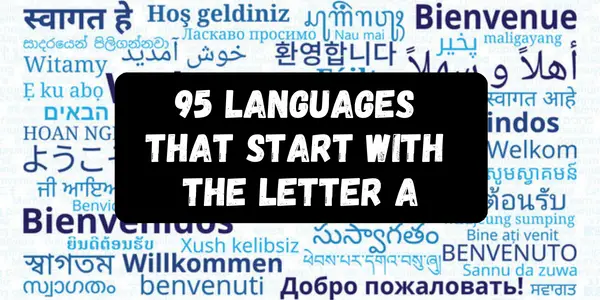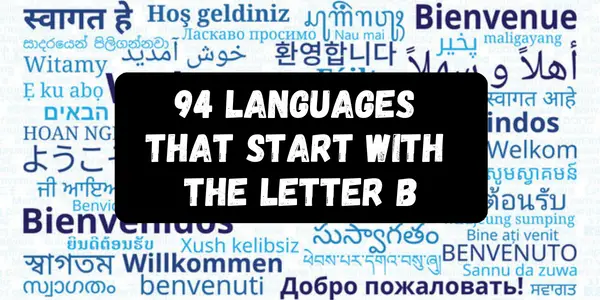Have you ever wondered about the vast array of languages that start with the letter Z? Wonder no more, you have come to the right place.
In this article, I will embark on a linguistic journey, delving into the rich tapestry of languages that begin with the letter Z. From the ancient to the modern, from the exotic to the widely spoken, these captivating languages hold a treasure trove of culture and history
So, without further ado, let’s dive into the fascinating realm of languages that start with Z and witness the beauty they bring to our world.
Languages That Start With The Letter Z
The followings are some of the most known and lesser-known languages that begin with the letter Z (In alphabetical order):
1. Zaghawa: Spoken primarily in Chad and Sudan, Zaghawa belongs to the Saharan branch of the Nilo-Saharan language family. With over a million speakers, it plays a crucial role in the social and cultural fabric of the Zaghawa people, known for their distinctive traditions and heritage.
2. Zakkur: This extinct language was once spoken in ancient Mesopotamia, specifically in the region of modern-day Syria. While there is limited information available about Zakkur, its historical significance in the ancient world cannot be underestimated.
3. Zande: Also known as Azande, this Central Sudanic language is primarily spoken in Sudan, the Democratic Republic of the Congo, and the Central African Republic. With a complex grammatical structure and distinctive tones, Zande has shaped the identity of its speakers, influencing their beliefs, customs, and way of life.
4. Zapotec: A family of indigenous languages, Zapotec is spoken in the southern Mexican state of Oaxaca. These languages have a rich cultural history, with deep connections to the ancient Zapotec civilization, famous for their remarkable archaeological sites like Monte Albán.
5. Zarma: Zarma, also called Djerma, is a Songhay language spoken mainly in Niger, as well as in parts of Mali, Benin, and Nigeria. With its extensive use as a lingua franca in the region, Zarma facilitates communication among diverse ethnic groups and has become an essential language for trade and cultural exchange.
6. Zaza: Zaza is an Iranian language spoken primarily in eastern Turkey. With an estimated 2 million speakers, Zaza represents an integral part of the local heritage, playing a significant role in preserving the identity of its speakers.
7. Zazaki: Another Iranian language spoken in Turkey, Zazaki has around 1.5 million speakers. It has faced challenges in terms of recognition and preservation, but efforts by the Zaza community and language activists continue to promote its use and safeguard its future.
8. Zeelandic: Zeelandic is a West Flemish dialect spoken in the southwestern Netherlands, primarily in the province of Zeeland. While Dutch is the official language of the Netherlands, Zeelandic serves as a regional identity marker and cultural treasure.
9. Zemba: Zemba, also known as Dzemba, is a Bantu language spoken in parts of Angola and Namibia. As with many Bantu languages, Zemba reflects the cultural diversity and historical connections of the communities it serves.
10. Zenaga: Zenaga is a Berber language spoken in Mauritania. As one of the oldest known languages in North Africa, Zenaga carries a wealth of linguistic and historical knowledge that provides insight into the region’s ancient past.
11. Zenati: Zenati is a branch of the Berber language family and includes various dialects spoken in Algeria and Morocco. With its diverse range of dialects, Zenati reflects the cultural diversity and unique identities of the communities that speak it.
12. Zhaba: Zhaba is a Tibetic language spoken in the Zhaba region of Sichuan, China. With a small number of speakers, the language faces challenges in terms of preservation and continuity.
13. Zhuang: Zhuang is a Tai-Kadai language spoken by the Zhuang people in southern China. As the largest minority ethnic group in China, the Zhuang have a rich cultural heritage that is intricately intertwined with their language.
14. Zhuang Dam: Zhuang Dam is a Zhuangic language, a subgroup of the Zhuang languages, spoken in Guangxi, China. The Zhuang Dam people have a unique cultural identity that is expressed through their language, customs, and traditional practices.
15. Zialo: Zialo is a Bantu language spoken in the Democratic Republic of the Congo. As part of the larger Bantu language family, Zialo showcases the cultural and linguistic diversity of the African continent.
16. Zimakani: Zimakani is a Papuan language spoken in Indonesia. Papuan languages like Zimakani contribute to the linguistic mosaic of Indonesia, reflecting the rich cultural heritage of its diverse population.
17. Zo: Zo is a Sino-Tibetan language spoken in parts of India and Bangladesh. With its unique tonal system and grammar, Zo represents the linguistic diversity found in the northeastern regions of South Asia.
18. Zoque: Zoque is a Mixe-Zoquean language spoken in the southern Mexican states of Chiapas, Tabasco, and Oaxaca. Zoque communities have a deep connection with their language, which is integral to their cultural practices and beliefs.
19. Zoroastrian Dari: Zoroastrian Dari, also known as Behdinan or Behdini, is an Eastern Middle Iranian language spoken by the Zoroastrian communities in Iran and India. As an ancient language associated with Zoroastrianism, it holds immense cultural and religious significance.
20. Zulu: Zulu is a Bantu language and one of the official languages of South Africa. With over 10 million speakers, Zulu is a vibrant and widely spoken language that plays a pivotal role in shaping South African culture and identity.
21. Zulu-Ndebele: Zulu-Ndebele is a dialect continuum spoken in southern Africa, primarily in Zimbabwe and South Africa. It is a testament to the intricate linguistic connections and historical migrations that have shaped the region’s linguistic landscape.
22. Zuni: Zuni is an isolate language spoken by the Zuni people in New Mexico, USA. With its unique linguistic features, Zuni is a key component of the Zuni people’s cultural heritage and traditions.
23. Zuni-Pueblo: Zuni-Pueblo, also known as Zuni-Papago, is a dialect of the Zuni language spoken by the Zuni people in New Mexico and Arizona, USA. The language has deep historical roots and plays a vital role in preserving the Zuni cultural identity.
24. Zuri’retan: Zuri’retan is a constructed language (conlang) with an unknown origin and purpose. Constructed languages like Zuri’retan are often created for artistic, fictional, or experimental purposes and can offer unique insights into linguistic creativity.
I hope you found this article “Languages That Start With Z” helpful and got insights into some of the rare and lesser-known languages around the world.
Also, keep in mind that, this isn’t an exhaustive list, if there are any Languages starting with the letter Z.
Feel free to leave a comment below with the missing Languages and I’ll update the list as soon as possible.
And, if you’d like to explore more Languages starting with different letters of the alphabet, click the link below:
- Languages That Start With A
- Languages That Start With B
- Languages That Start With C
- Languages That Start With D


